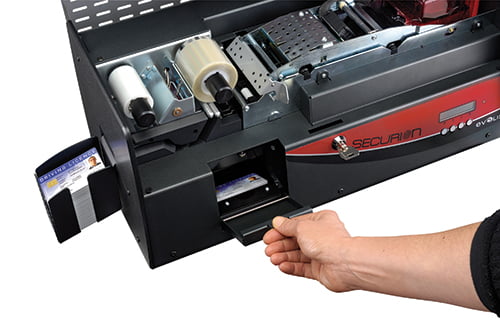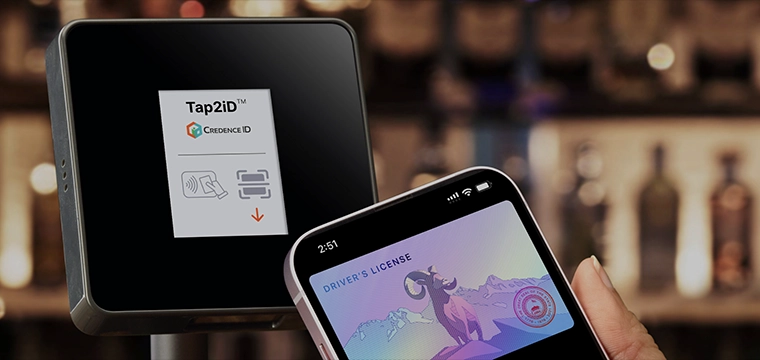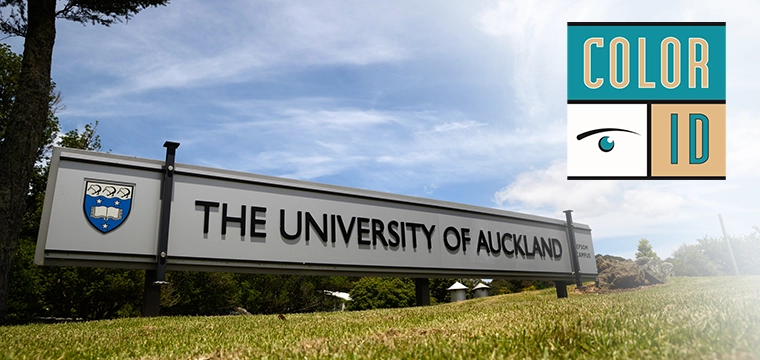
The list of goals for campus card offices varies depending on the institution, its size and how it plans to use the student credential. However, there is one goal that seemingly runs the gamut–reducing cost.
It’s hard to ignore an opportunity to cut card issuance costs, but saving money cannot come at the expense of the card office’s efficiency and effectiveness. Where, then, should an institution looking to cut card issuance cost turn? The printer is a good place to start.
“Printer manufacturers have made it easier for campus card offices to produce professional badges for their students and employees without breaking the bank,” explains Elisabeth Afriat, marketing director at ID Security Online. “From money-saving card printer options to cost-effective ribbon solutions, each campus can now build a successful and affordable ID card program.”
A lot has changed in the printer market, as new technologies have given rise to a new level of card printer. The latest ID card printers are much faster and more efficient than older models, which helps reduce downtime and increase productivity–advancements that, as Afriat explains, are reflected in the bottom line.
“Campuses using an outdated printer should consider that the cost of consumables and support is on average 50% higher for an older printer than for a new one,” says Afriat. Campus card managers can often receive trade-in rebates for old systems.
Saving money at the card printer requires a card office to first consider the scope of the institution’s program. “Defining the design of the ID cards, along with the data and security features that will be embedded in the cards, is critical to avoid costly mistakes,” says Afriat.
To avoid costly mistakes, Afriat explains that the campus card manager should seek answers to four key questions:
The type of printer used offers an opportunity to shave overhead costs, says Amber Hanson, senior manager of eCommerce AlphaCard.
“Instead of using expensive duplex printers–which automatically flip cards to print front and back in one run–many schools elect to use a single-sided printers and to preprint the back of the card with generic information,” explains Hanson. “The back of most cards are printed with information that is the same for each student, while the fronts are custom printed as needed.”
Another feature that should be considered when selecting a printer is the availability of field-upgradable modules, explains Afriat. Many card printers can be upgraded onsite to adapt to evolving needs, which can cut start-up costs.
“This means that there’s no need to get a brand new machine to add a printing or encoding feature,” explains Afriat. “And you don’t need to buy a full-featured printer up front.” She says today’s most common options are dual-sided printing, encoding and Ethernet connectivity modules.
One more printer consideration involves the printing process itself, says Brett St. Pierre, western regional manager at HID Global.
Direct-to-card technology uses a print head to apply dye directly onto the plastic card surface. Retransfer technology applies the dye to a clear transfer film, which is then adhered to the card itself.
The retransfer process reduces the print head damage that can occur when the print head makes contact with the plastic card, and any dirt or imperfections, in the direct-to-card process, explains St. Pierre.
Universities can also save money by using a monochrome black ribbon to pre-print the back of the card, as opposed to using a full color ribbon to print in black. Pre-printing the generic card information with a black ribbon is much less expensive than wasting a full color ribbon to print a single color.
The card back can also be preprinted before the cards arrive on campus eliminating the need to print this side of the card onsite altogether. “Preprinting the backs can reduce print times dramatically,” says Mark Degan, corporate marketing manager at ColorID. “And the cost typically evens out whether preprinting the backs or buying a different ribbon and printing them in house.”
Some campuses even opt to preprint the static elements on the front as well. “Pre-printing cards with certain information ahead of time–school seal, logo, mission statement and other visual security elements–can be done either in-house or through a third-party service,” says St. Pierre. “The remaining items can be printed at the time of issuance using faster, partial-ribbon printing on one side of the card only.”
This not only cuts print time, but also reduces ribbon and transfer film costs, St. Pierre explains.
Preprinting static color elements on the front can result in cards that are less prone to fade over time and have superior image resolution and quality. “With this fully preprinted card stock, half panel ribbons are a great option because the campus only has to print the photo and variable text,” Degan adds.
While the printer itself is a vital piece of the puzzle, Afriat explains that the most common mistake is selecting the wrong consumables. “Most campuses use a standard YMCKO color ribbon to print their student badges, neglecting two cost-effective options: YMCKO-K and half-panel color ribbons.”
YMCKO-K is a dual-sided, six-panel card ribbon that prints full color on side one and black–represented by the additional “K”–on side two.
“When printing dual-sided badges, a YMCKO ribbon is the right choice if the front and back of the card are printed in full color,” says Afriat. “But if the back is only printed in black, a YMCKO-K ribbon is a lot more cost-efficient.”
An underutilized cost-cutting option is the half-panel color ribbon. “In half-panel color ribbons, the Yellow, Magenta and Cyan panels are half the size of the regular panels of a YMCKO ribbon,” explains Afriat. “This means that up to half of the card can be printed in full color while black information can be printed anywhere on the card.”
For many campus IDs only the student’s photo ID and the school’s name or logo is printed in color. “If these color items are placed on the same half of the card, buying a half-panel color ribbon will deliver twice the number of prints that a regular YMCKO ribbon produces.” This one move can cut an office’s ribbon costs essentially in half.
Another opportunity to cut consumable costs is with the card stock, though not in the way you would expect. “We recommend using a composite card–a blend of polyesther and PVC–as it reduces the ID office’s need to reissue cards due to cracking from wear and abuse,” says Degan. “Composite material helps guard against damage from bending, improper use and adverse weather.”
AlphaCard’s Hanson explains that higher quality card stock, though more expensive, can save in the long run. “Campuses often have to replace cards due to breakage so they can actually save money by using durable polyester/PVC blend cards,” says Hanson. “Although the upfront cost is greater, these cards bend more before breaking and withstand more abuse.”
Hanson suggests providing students with ID card holders to protect cards and eliminate the temptation to hole punch the card or store it in an unprotected manner. Students often punch holes in their cards so they can put them on a key ring or lanyard, but this is a common source of card breakage.
It pays, also, to keep up with the trends in advancing identification technology, explains HID Global’s St. Pierre.
He suggests that going contactless eliminates card replacement costs that can result from mag stripe damage or demagnetization–common occurrences when cards are used frequently. “It also eliminates fraud-related losses associated with mag stripe technology that typically has little or no security protections.”
Another important consideration when saving money at the printer is the manpower that supports the card operation. Hanson insists that proper training and maintenance will be key for any card operation looking to conserve resources over the lifespan of a card solution.
“Properly maintaining an ID card printer saves dollars by minimizing downtime for repair,” explains Hanson.
Printer maintenance is often considered a chore, but it’s often the small measures that make the biggest impact.
“Make sure to use a cleaning kit every time the ribbon is changed out. You can also use a can of condensed air, or blow through a straw to remove built up dust inside the machine,” Hanson explains. “With proper care, ID card printers are much less likely to suffer damage to the print head. Typically, print heads cannot be repaired and cost around $700 to replace.”
“When searching for an ID Card Printer dealer, look for companies that include training and support in the purchase of the system,” says Hanson. “Even if the institution itself have to pay for training and support, we highly recommend it because even simple mistakes can cause printer damage, or waste printing supplies.”
Though it may not be as apparent as the savings from printers and consumables, another way to save money in card production is to make the credentials themselves more valuable to the student. Adding features to the card creates a sense of responsibility amongst students, encouraging them to protect and keep track of their ID, Afriat explains.
No matter how you cut it, card issuance is a necessary expense for universities, but cutting costs doesn’t have to come at the expense of student safety and convenience. The number of applications that modern campus cards can deliver is vast. So too are the number of printers and consumables. Rest assured, a winning combination is out there. It’s a combination that, when properly struck, can provide relief to campus card offices and their budgets alike.
AlphaCard reveals a list of practices and features that can help a card office to cut start up and overhead costs.
Printer Speed: As the old adage goes, time is money. Saving even a few seconds per print can really add up for schools that print large batches.
Hopper Size: Larger input and output hoppers can save schools time when printing larger batches. Many ID printers come with hoppers with a 50 card capacity, which means the user has to reload five times before a standard 250 print ribbon is used up.
Supply Costs: Evaluate the average cost for supplies per card for each printer. Mid to high level ID card printers are geared towards higher volume, and generally offer a lower cost per card for ribbons and cleaning kit supplies.
Printer Warranty: A good warranty can save schools thousands of dollars in repair costs. Some warranties include free loaner coverage to help reduce internal costs of downtime.
Energy Star Rating: Many newer printers have an Energy Star Rating and will save on electricity consumption.
High Yield Ribbon: Consider printers that offer high-yield ribbons that provide a lower cost per card and will save on operational costs, as the user doesn’t need to change the ribbon or clean the printer as frequently.
Ribbon Refill: Fargo is offering a new ECO Refill Ribbon for certain printer models. Instead of throwing away both the used ribbon and the cartridge, schools can order special cartridges that can be re-spooled with a refill ribbon. In addition to reducing waste, this will also save a school in overall ribbon costs. Just make sure the user doesn’t’ accidently through away the cartridge with the used ribbon!
Choose a printer with efficiency features that help to speed badging and reduce registration lines, recommends Brett St. Pierre, western regional manager at HID Global. Important features to consider include:




